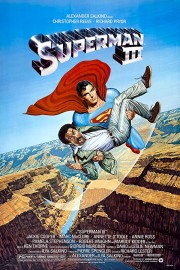Superman III
The tone for “Superman III” is set during the opening credits. Mishap after mishap, accidents resulting in dangerous situations that only Superman can solve. The results are comedic gold, right? Right?
Comedy is the big idea that seems to be at the heart of David and Leslie Newman’s script, and the way Richard Lester (who was brought in to finish “Superman II” after Richard Donner was fired) directs the film. Of course, a big part of the emphasis on humor is the co-starring role of Richard Pryor as Gus Gorman, a computer programmer who becomes part of the nefarious schemes of a Metropolis businessman (Robert Vaughn). The thing that gets Gorman noticed is a program that takes the decimal points that companies round down from people’s paychecks. Sound familiar? They did something similar in the cult hit “Office Space,” where they acknowledge the homage. “It’s like in ‘Superman III,'” the refrain goes.
Pryor tries hard to make the comedy work, but the film is too much of a mess in terms of tone. Is this supposed to be a comedy or a “Superman” movie, because it doesn’t really work as both. The script relies way too much on coincidence, even for a Hollywood action movie. Superman/Clark Kent (Christopher Reeve) is too much of a side character for the first half of the film, which could be called the Gus Gorman Show, although in the second hour, that’s corrected in a big way by the film’s most inspired touch.
After foiling the big plans Vaughn’s Ross Webster has for trying to control the world’s coffee supply, Superman is on Webster’s hit list. Vaughn enlists Gus to use a secret satellite to head towards the place in space where Krypton was, and analyze debris of Kryptonite. Webster’s people replicate the substance, and get it to Superman. The catch is, one of the original substances is an “unknown” one, so Gus improvises. The results don’t kill Superman, as real Kryptonite would, but it does turn him into a bad guy, giving Reeve a chance to drop the Boy Scout attitude, and play something more sinister. This is the part of the film that works best, and worked best for me watching it back in the ’80s. This type of inner turmoil is something that always brings out the best in superhero franchises (and I think my appreciation for this stretch of this film is why I love the similar moments in the much-maligned “Spider-Man 3”), and when it comes to a head in a junkyard, and Kent is fighting bad guy Superman, it’s a genuinely tense moment. It’s also important that it’s Kent and not just good Superman fighting his evil self; that makes the payoff much more satisfying when Clark takes control of the persona again.
After that conflict is resolved, however, it’s back to the main story with Webster and Gus, who isn’t really a bad guy, but just finds himself doing bad things for Webster. We know he’ll turn on Webster by the end because, let’s face it, Pryor isn’t the co-star for the purpose of being a villain; he’s the comic relief. That’s a concept this film doesn’t understand too well, as it relies too much on “comedy” rather than letting funny things happen naturally in the story. A better movie would have tried to challenge Pryor as an actor rather than just trying to adapt the genre to his persona; of course, a better movie would have succeeded at the latter, as well. But we were still a long way from the “Iron Mans” and “Dark Knights” of the movie landscape. The mega-computer at the end is cool, as well as the way it becomes self-aware, fitting into the traditional sci-fi notion of technology gone haywire. It’s a little too late to save the film as a whole, but it shows that the filmmakers ideas weren’t all bad. They just didn’t do a great job bringing it all together into a satisfying package.










